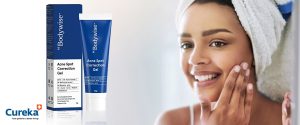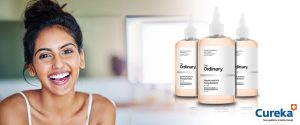Want to Try Glycolic Acid in Skincare? Here’s what you Need to Know
When it comes to skincare there arise numerous suggestions and ideas from natural home remedies to cosmetic products in the beauty market. But wouldn’t it be great to set the record straight with cosmetic dermatologists? Here’s some advice we’ve collected from the professionals.
The word acid reminds us of the test tubes used in chemical labs and scary burns. But using acids like glycolic at the required concentration is one of benefits of skin care. This is a miracle tool used to fight acne, acne scars, age spots, melasma, photodamage and uneven skin tone. To choose what to use? how to use it? And when to use it? Feel free to consult a professional for tailored guidance and immediate results.
Acne care and anti-aging care are the most sought after skincare concerns, for both men and women. An ingredient that does wonders on all skin types, from dull to rough, and most used by professionals, is plant-based natural acid from sugarcane ‘GLYCOLIC ACID’. In this blog we’ll discuss the various benefits we found, of alpha-hydroxy acid in skincare.
What is the Role of Glycolic Acid as Peeling Agent?
Glycolic acid peels work miracles for various indications such as, acne, acne scars, postinflammatory hyperpigmentation, photoaging, melasma, and seborrhea. GA peeling is also available combined with Vitamin C. Targeted for cases of melasma and post-inflammatory hyperpigmentation.
Doctor’s Note: Peeling is the application of chemicals to skin surface leading to exfoliation and removal of superficial lesions, followed by the regeneration of new skin cells. Glycolic acid (GA) is obtained from sugarcane and is used as the most common alpha-hydroxy acid peel.
GA has the smallest molecular weight amongst all the alpha-hydroxy acids thus has easier penetration onto the skin and makes it a popular peeling agent. Glycolic acid peels are commercially available as free acids, partially neutralized (higher pH), buffered, or esterified solutions. They are available in various concentrations ranging from 20%–70%. The higher the concentration and lower the pH; the more intense the peeling will be.
What are the Benefits of Glycolic Acid in the Skin?
GA works by increasing the water holding capacity due to AHA application along with increase of skin hydration and skin turgor.
Doctor’s Note: AHA induces desquamation, plasticisation and normalisation of epidermis all differentiation by interfering with intercellular ionic bonding thereby reducing corneocyte cohesion and thus inducing keratolysis .
Glycolic acid (GA) has anti-inflammatory and photoprotective effects against UVB-irradiation in keratinocytes. They are also helpful in stabilizing oily or acne-prone skin and improving skin tone.
Alpha hydroxy acids encourage the shedding of old pigmented, sun-damaged skin cells that are on the surface of the skin. They loosen the glue-like substances that hold the surface skin cells to each other, therefore allowing the dead skin to peel off gently.
Is Glycolic Acid Good for your Skin?
AHAs can be a friend or a foe to your skin. Depending on its concentration. The effectiveness of AHAs is also dependent on pH and exposure time.
These mechanisms of glycolic acid are currently well understood, aiding the development of novel approaches for the prevention of UV-induced skin damage. Glycolic acid improves the collagen content of your skin, thickens the outer layer of your skin, and acts as anti-aging. It makes the skin appear plumper and even in texture. Increases new fibroblast cells.
Glycolic acid acts as an anti-clogging agent by clearing up the excess oil and dead cells that block the pores of the skin. It also has minor action against Propionibacterium acnes, one of the bacteria that causes acne.
Glycolic acid is better as gel or cream or cleanser?
How to use Glycolic Acid in your Daily Skincare?
It is OK to use 1-2% containing glycolic acid face wash or ointments for everyday use. The creams have a higher glycolic acid content (10% and above) and must only be used once or twice a week to avoid skin irritation.
The creams with a concentration above 15% can be kept for a few minutes and then wiped off.
Gel formulations have a slower penetration time and are easier to control.
Doctor’s Note: Any cleanser with a glycolic acid content of more than 20% should be used under professional medical guidance only.
Where to Begin?
Its important that you get glycolic acid peel with a qualified cosmetic dermatologist. Any type of peeling method should be decided by healthcare provider based on your skin condition, whether it is oily, acne prone, rough and so on. Only a qualified professional can make educated decisions and monitor the treatment progress and give you the aspired results.
Does Glycolic Acid Play Role in Treating Melasma?
Doctor’s Note: Melasma is a common disorder of facial hyperpigmentation among women due to hormonal changes and imbalance.
The basic mechanism of the action of chemical peels in melasma is the removal of excess melanin by causing a controlled chemical exfoliation to the skin.
Glycolic acid gently exfoliates the hyperpigmented patches, thus reducing pigmentation and is sometimes mixed with other skin lightening agents like hydroquinone to treat melasma.
What are the Measures to be Followed Post Glycolic Acid Peel?
Keep the skin moisturized, stay away from sun, avoid exfoliators, do not rub the skin, do not use hot water shower on inflamed skin, avoid picking on the scabs if any formed post peel, avoid cosmetics until the peeling subsides and let the skin work on its own to give a fresh skin with new cells.













